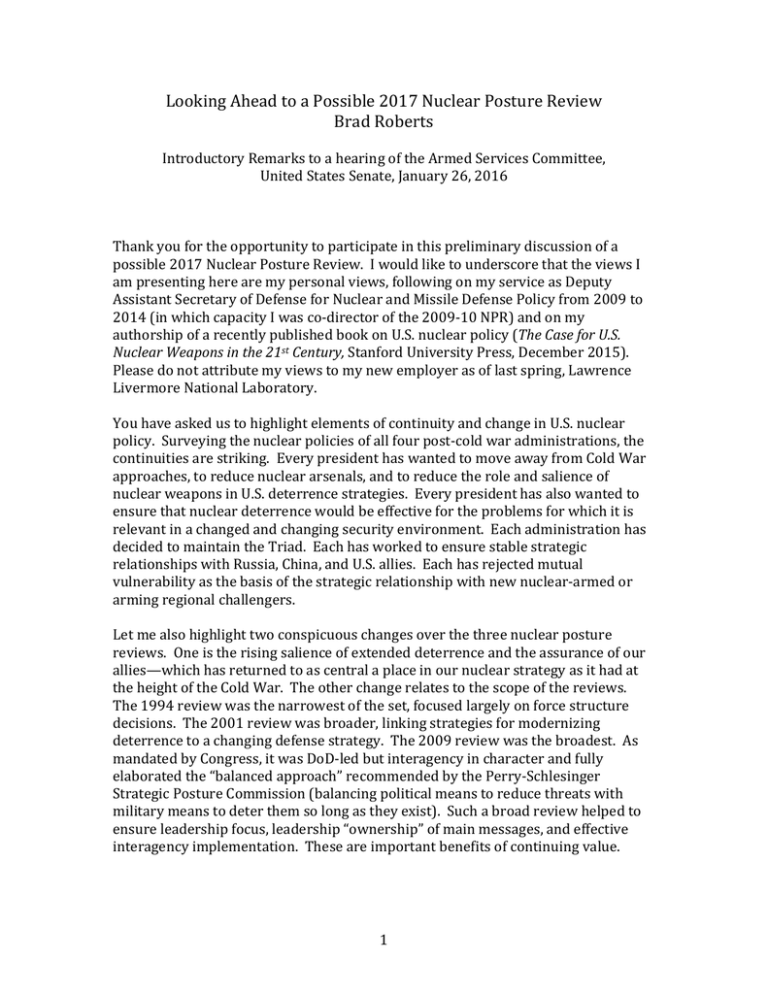Looking Ahead to a Possible 2017 Nuclear Posture Review Brad Roberts
advertisement

LookingAheadtoaPossible2017NuclearPostureReview BradRoberts IntroductoryRemarkstoahearingoftheArmedServicesCommittee, UnitedStatesSenate,January26,2016 Thankyoufortheopportunitytoparticipateinthispreliminarydiscussionofa possible2017NuclearPostureReview.IwouldliketounderscorethattheviewsI ampresentingherearemypersonalviews,followingonmyserviceasDeputy AssistantSecretaryofDefenseforNuclearandMissileDefensePolicyfrom2009to 2014(inwhichcapacityIwasco‐directorofthe2009‐10NPR)andonmy authorshipofarecentlypublishedbookonU.S.nuclearpolicy(TheCaseforU.S. NuclearWeaponsinthe21stCentury,StanfordUniversityPress,December2015). Pleasedonotattributemyviewstomynewemployerasoflastspring,Lawrence LivermoreNationalLaboratory. YouhaveaskedustohighlightelementsofcontinuityandchangeinU.S.nuclear policy.Surveyingthenuclearpoliciesofallfourpost‐coldwaradministrations,the continuitiesarestriking.EverypresidenthaswantedtomoveawayfromColdWar approaches,toreducenucleararsenals,andtoreducetheroleandsalienceof nuclearweaponsinU.S.deterrencestrategies.Everypresidenthasalsowantedto ensurethatnucleardeterrencewouldbeeffectivefortheproblemsforwhichitis relevantinachangedandchangingsecurityenvironment.Eachadministrationhas decidedtomaintaintheTriad.Eachhasworkedtoensurestablestrategic relationshipswithRussia,China,andU.S.allies.Eachhasrejectedmutual vulnerabilityasthebasisofthestrategicrelationshipwithnewnuclear‐armedor armingregionalchallengers. Letmealsohighlighttwoconspicuouschangesoverthethreenuclearposture reviews.Oneistherisingsalienceofextendeddeterrenceandtheassuranceofour allies—whichhasreturnedtoascentralaplaceinournuclearstrategyasithadat theheightoftheColdWar.Theotherchangerelatestothescopeofthereviews. The1994reviewwasthenarrowestoftheset,focusedlargelyonforcestructure decisions.The2001reviewwasbroader,linkingstrategiesformodernizing deterrencetoachangingdefensestrategy.The2009reviewwasthebroadest.As mandatedbyCongress,itwasDoD‐ledbutinteragencyincharacterandfully elaboratedthe“balancedapproach”recommendedbythePerry‐Schlesinger StrategicPostureCommission(balancingpoliticalmeanstoreducethreatswith militarymeanstodeterthemsolongastheyexist).Suchabroadreviewhelpedto ensureleadershipfocus,leadership“ownership”ofmainmessages,andeffective interagencyimplementation.Theseareimportantbenefitsofcontinuingvalue. 1 FromthevantagepointofJanuary2016,whatarethekeyelementsofchangeand continuitybearingontheU.S.nuclearposture?Iwillbrieflyhighlightherefourkey changes. 1. WiththeabruptturninRussiansecuritypolicyinspring2014,itisnolonger possible,asitwasin2009,tocharacterizetherelationshipwithRussiaas improvingandpresentingminimumrisksofarmedconflict.Butasthenew threatisprincipallytoourNATOallies,ournationalresponseneedstofocus onadaptingandstrengtheningdeterrenceinEurope.Thisprocessbegan withthe2013Walessummitandwillbeacceleratedattheupcoming Warsawsummit.DoesthisrequireachangeinU.S.nuclearpolicyorposture, separateandapartfromNATO’sposture?Thecurrentpostureissizedand structuredtomaintainstrategicstabilitywithRussia.TheObama administration,likeitspredecessors,hasmaintained“secondtonone”asa guidingprincipleandhasmaintainedtheresilienceoftheforcesothatitis notvulnerabletoapreemptivestrike.Theargumenthasbeenmadethat Russia’snuclearassertivenessrequiresaparallelnuclearassertivenessby theUnitedStatesandthatitslargeanddiversetheaternuclearforcerequires asymmetricNATOnuclearforce,alongwithanewgenerationofultralow‐ yieldweapons.ThedeficienciesinNATO’snuclearposturearenotinits hardware,however,whichisrobustforthedeterrenceofRussiande‐ escalationstrikes.Thedeficienciesareinitssoftware—inthewaysinwhich theAllianceexpressesitsconvictionsabouttheroleofnucleardeterrence (andwhichwillbeaddressedinWarsaw). 2. Intheperiodsince2009,wehavelearnedthattheconditionsdonotnow exist—andarenotproximate—thatwouldallowustotakeadditional substantialstepstoreducetheroleandnumberofU.S.nuclearweapons.The Obamaadministrationsetoutapracticalagendaforseekingcooperation withothernuclear‐armedstatestomoveinthisdirection.Whatarethe results?Russiahasprovenunwillingtotakeanadditionalone‐third reduction.Chinahasprovenunwillingtoembracenewtransparency measures—oreventodiscussstrategicstability.NorthKoreahascontinued itsnuclearbuildup.OuralliesareunwillingtoabandontheU.S.nuclear capabilitiesuniquelyassociatedwithextendeddeterrence(i.e.,non‐strategic nuclearweaponsforward‐deployedordeployable).Thisdoesnotmeanthat theUnitedStatesshouldabandonthearmscontrol,nonproliferation,and disarmamentprojects.Doingsowouldonlyfurtheraggravatetheproblem. Weshouldnotabandonthe“balancedapproach.”ButtheUnitedStates shouldtemperitsexpectations.Anditshouldrefrainfromunilateralsteps thatsupposedlyputpressureonotherstojoinus.Ifitmadenosensein2009 totakeunilateralactiontoeliminatealegofthetriad,itmakesevenless sensetoday. 3. Intheperiodsince2009,themoremultidimensionalnatureofstrategic conflicthascomemoreclearlyintofocus.Nuclearweapons,missiledefense, cyber,andspacemaybeseparatedomains,buttheyareallpartofthesame strategiclandscape.Thisputsafocusonthechallengeofensuringthe 2 neededdegreeofintegrationinpolicy,strategy,andexecution.Thisinvites animportantquestionaboutthescopeofapossible2017review.The Obamaadministrationconductedasetofseparatebutlinkedreviewsof thesedifferentpostureelements.Mightanalternativeapproachenablemore effectiveintegration?Possibly.Butasingle,comprehensivestrategicreview wouldbedifficulttodoonaninteragencybasis,whereasthe2009NPR benefitedsignificantlyfromthatinteragencyaspect. 4. Afinalkeydifferenceisinthepoliticalcontext.IntheleaduptotheObama administration,executive‐legislativegridlockhadpreventedany modernizationdecisions.TheStrategicPostureCommission(SPC)helpedto remedythatproblem,withitsbipartisanadvicetotheObamaadministration topursuemodernizationbylifeextension,whichtheadministration accepted.Intheinterim,wehavenotrecoveredabroadanddeepbipartisan consensusonnuclearmodernization.Butwehaveachievedsufficient agreementwithinandacrossthepartiestoenableaseriesofpositive decisionstosupportmodernizationwithsteadilyincreasinginvestments. Thisneedstobepreservedandnurtured.RepeatingtheSPCwouldnotbe usefulornecessarytowardthatend.Aprivatebi‐partisaninitiativecould, however,helpsettherightcontextandprovidetherightmarkersforthe journeyahead. Letmeroundoutmyintroductoryremarksbyhighlightingthreekeyelementsof continuitysince2009. 1. AsiaisasrelevanttotheU.S.nuclearpostureasisEurope.China’snuclear futurehasnearlyasmanylargequestionmarksasdoesRussia’s.Ourpursuit ofstrategicstabilitywithbothneedstocontinuetoadapt.OurNortheast Asianalliesareasanxiousaboutextendeddeterrenceinachangingsecurity environmentasareourCentralandNorthernEuropeanallies.Don’tletthe Russiaproblemdistractusfromthisstrategictruth 2. Westilldon’thavethehedgewesaywewant.Eachadministrationsincethe ColdWarhaswantedtoensurethatwehaveastrongnationalcapacityto respondtobothgeopoliticalandtechnicalsurprises.Eachhaswantedto reducerelianceonalargeandexpensive‐to‐maintainstockpileofaging nuclearweaponsasahedgeagainstuncertaintybyincreasingrelianceona responsiveandadaptivenuclearweaponscomplex.TheStrategicPosture Commissionputspecialemphasisonthispoint.Fixingthisproblemwiththe properinvestmentandgovernancestrategiesshouldbeakeypriority.I knowofnoonewhothinksthattherisksofgeopoliticalandtechnical surprisearedeclining. 3. Eachadministrationhasdebatedwhethernewnuclearweaponsareneeded –andwearecertaintohavethisdebateagain.TheGeorgeW.Bush administration’spursuitofnewweaponscametoapoliticaldeadend.The Obamaadministration’spursuitofamodernarsenalthroughthelife extensionofexistingcapabilitieshasbeenmoresuccessful.Therearetwo argumentsfornewweapons—thatweneedthemfordeterrenceandthatwe 3 needthemtosustainournationaldesigncompetence.Bothargumentshave somemerit.Butthereisnogoodreasontothinkthatanewefforttobuild newweaponsfornewmilitarypurposeswouldnottoocometoapolitical deadend.Moreover,thereareothermeanstostrengthendeterrenceand sustaindesigncompetence. Thankyoufortheopportunitytojoininthisdiscussion.Ilookforwardtoyour questions. 4





